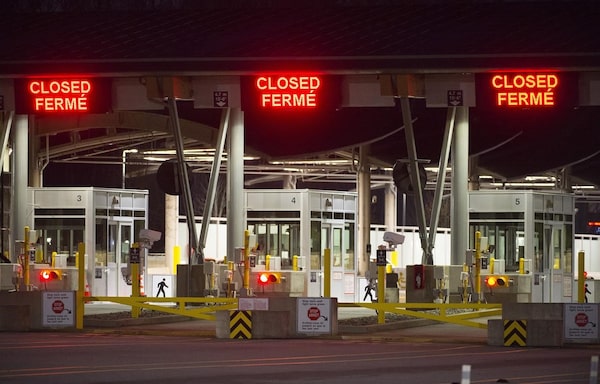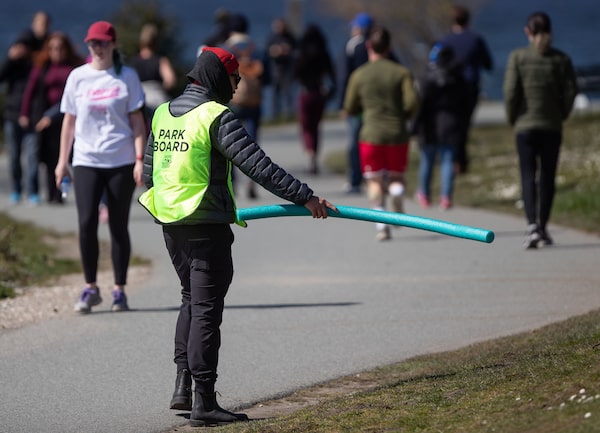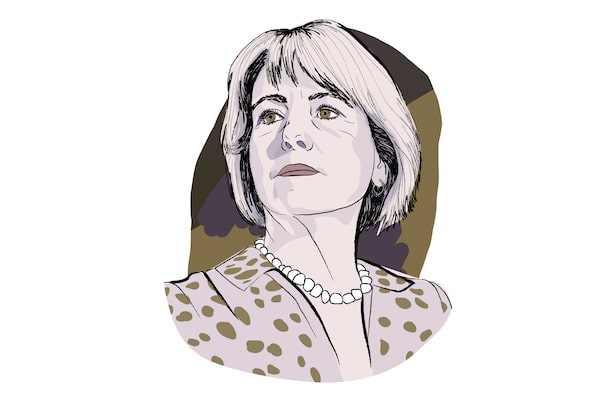Victoria, April 23: Dr. Bonnie Henry, B.C.'s top health official, leaves the Health Ministry office at the legislature in Victoria en route to her daily COVID-19 news conference.Chad Hipolito/The Globe and Mail/The Globe and Mail
When Dr. Bonnie Henry thinks back to the first, nerve-wracking weeks of B.C.’s response to the COVID-19 emergency, the Provincial Health Officer recalls a three-day span in which she couldn’t sleep.
The novel coronavirus epidemic arrived on Canadian shores in the early weeks of January. British Columbia became newsworthy as the province with the most cases. Dr. Henry, until then a mostly anonymous civil servant, became the public face of the government’s response to the crisis.
Having worked for the World Health Organization and Toronto Public Health, she was experienced fighting SARS, Ebola and H1N1. But this was different – she was now in charge of directing the strategy. As the virus began to spread in the province, lives were being lost. More were on the line. With thousands of people set to head off on spring break, she suddenly felt the burden of her responsibility.
“I would say March 11th, 12th and 13th are key dates for sure,” Dr. Henry said. “I don’t think I slept at all any of those nights. You’re wondering: are we doing enough? Are people going to say we’re overreacting? Those were certainly some of the things that were going through my mind.”
It was in that 72-hour period that Dr. Henry and top political and medical officials made decisions that helped put B.C. on a relatively quick path to flattening the growth of the novel coronavirus in a way that provinces such as Quebec and Ontario were not able.
Dr. Henry has regularly been the object of praise for her crisis leadership. But in an extensive interview she conceded that, in the early going, there were no assurances that cases of the virus wouldn’t quickly reach a critical state. “You’re never sure how people are going to respond to various orders,” she said. “In some ways, you’re never sure how big the problem is at the beginning, what you really have on your hands.”
The days leading up to those sleepless nights had been unnerving ones.
By then, Dr. Henry had been in regular contact with her counterparts in the Pacific Northwest, and in Washington State in particular, which B.C. abuts. The state had the first confirmed case of the disease in the United States on Jan. 20. And while the number of reported cases slowly continued to grow, the belief among state health officials was the disease was actually far more widespread than the numbers told.
She was also starting to get some intelligence in from Quebec, which began its spring break on Feb. 29. The later school break, Dr. Henry admits, was a key bit of good fortune for B.C. She learned, for instance, there were detected cases of the virus among people returning to Quebec from their holidays in France. And her contacts said there were also cases found among people returning from New York and Florida, both states that would later be deemed virus hot spots.
As late as the afternoon of March 11, in her daily briefing that began in late January, Dr. Henry said it was still okay to travel within Canada, but suggested people avoid cruise ships and “think twice” about travelling outside the country. The beginning of B.C.’s own spring break was now just three days away.
Dr. Henry's COVID-19 briefings, which she started giving daily in January, have been a regular fixture for British Columbians as the provincewide physical-distancing measures continue.Chad Hipolito/The Globe and Mail/The Globe and Mail
If Dr. Henry wasn’t sounding overly alarmed about what was taking place, it was perhaps understandable.
In Ottawa, the country’s top public-health official, Theresa Tam, was suggesting as late as March 11 that people older than 65 with compromised immune system were the ones primarily at risk of contracting the virus and they should avoid large public gatherings.
Still, it was during that first sleepless night of March 11 that Dr. Henry began to question whether the measures she had in place were enough. The number of confirmed cases of the virus in B.C. had continued to climb since the first one was reported.
She now knew the virus had been imported by people returning from Iran and the U.S., specifically Washington State. But there was community spread as well. By March 11, the number of cases had risen to 46. The province had also recorded the first death from the disease in the country on March 8.
Dr. Henry was processing all of the local, national and international data that were coming in at a furious rate and changing almost hourly.
If Quebec was worried about an explosion in cases as a result of people returning to the province from holidays, then she should be too. If people in B.C. went off in all directions during spring break then the province would be inviting the same problems that Quebec was anticipating. Dr. Henry did not want that.
B.C. Health Minister Adrian Dix looks from the sidelines as Dr. Henry gives her April 23 briefing. In March, Mr. Dix would support her in introducing stricter rules on travel.Chad Hipolito/The Globe and Mail/The Globe and Mail
On the morning of the 12th, she took part in a regular call with the Canadian health special advisory committee, a group of public-health officials from across the country. As representatives from every province and territory gave an update, it was clear that trouble lay on the short-term horizon.
Around 1 p.m., she convened a meeting with B.C.’s Minister of Health, Adrian Dix, and his deputy. She told them she felt the province needed to institute stricter rules around travel. It was a difficult call: People would have made spring break plans months earlier. But time was short and the consequences of not issuing a directive now would be deadly. Mr. Dix agreed and phoned Premier John Horgan, knowing he’d go along with whatever his top public-health official was recommending. He did.
Two hours later, Dr. Henry announced that she was advising against all non-essential travel outside Canada, including the U.S. And anyone arriving from outside the country would have to self-quarantine for 14 days. (A move Quebec had already instituted). The following day, the PHAC would issue the same directive on non-essential travel outside the country.
Behind the scenes, B.C. was also leading the campaign to have Prime Minister Justin Trudeau close the border to the U.S. to all but essential travel. On March 16, Mr. Trudeau announced a ban on international travellers entering the country – but exempted the U.S.
Mr. Dix was not amused and felt he had a duty to issue his own directive, even if it didn’t carry any weight legally.
“Don’t come,” B.C.’s Health Minister said at that day’s press briefing, when asked what he’d say to U.S. citizens thinking of visiting the province. “Please, don’t come.” Many Americans listened. Canada and the U.S. would agree to close the border to non-essential travel on March 22.

Surrey, B.C., March 20: Entry points at the Peace Arch border crossing are closed after the restrictions on non-essential travel between Canada and the United States were announced.Jonathan Hayward/The Canadian Press/The Canadian Press
Over the ensuing days, Dr. Henry would introduce ever-stricter measures – prohibiting gatherings of more than 50 people, closing schools, bars and restaurants. These were policies adopted by virtually every province in the country over the same period of time. But B.C. also introduced significant changes at long-term care homes – ones many credit for the low number of outbreaks at these institutions compared with provinces such as Quebec and Ontario.
B.C. began screening all staff working at these facilities for symptoms of the disease and made masks and gloves mandatory. On Dr. Henry’s orders, care homes banned residents from having outside visitors. B.C. was also the first province to prohibit care home workers from bouncing from facility to facility – which made transmitting and spreading the virus too easy.
Throughout the early weeks of the new world she was helping British Columbians navigate, Dr. Henry remained a reassuring voice. She wasn’t afraid to show a vulnerable side. At one news conference, she teared up while discussing the impact the disease was having on families at long-term care homes. She was praised for demonstrating a level of empathy rarely conjured by public officials.
It was the point at which Dr. Henry became a fixture in the consciousness of most British Columbians. An artist painted an image of her – and Dr. Tam – on the boarded up storefront in Gastown. Her love of John Fluevog shoes, which were evident every time she strode to the podium to give her daily update, became a provincial talking point. The designer, in turn, decided to honour her by designing a shoe in her name, embossed with the words she often used to end her news conferences: ‘Be kind, be calm, be safe.’ While flattered by all the attention, Dr. Henry has remained singularly focused on the monumental challenge before her.
And changing the rules of engagement along the way.
Along with Mr. Dix, for instance, Dr. Henry decided to show the public-health modelling upon which they were basing their decisions. It was a wise move eventually copied by other jurisdictions.
“We were asking people to sacrifice a lot,” Mr. Dix said in an interview. “And we just felt we owed it to them to show the information we were basing our public policy decisions on. It was also important to illustrate how quickly the data could change, which forced us to make changes in our orders as well.”

Vancouver, April 5: A park board employee uses a prop to show how far apart people should be at the seawall at English Bay.Darryl Dyck/The Canadian Press/The Canadian Press
Interestingly, while B.C.’s stringency level – the regime of public restrictions that is actually measured – was as high as most provinces, there were key differences. For instance, Dr. Henry said she believed it was important for people to get out and walk and exercise in parks and elsewhere – activities that could land you a fine in provinces such as Ontario if you stopped too long while strolling.
B.C.'s top doctor decided to treat the province’s citizens like adults, give them permission to walk freely but at a safe distance from one another. When people abused that freedom, she admonished them, but in the nicest way. “Again these measures are not forever,” she would say, “but they are for now.”
Dr. Henry was stoic amid the inevitable criticism that some of her policies incited. She was upbraided by some doctors over her decision not to test every single person who exhibited symptoms of the disease – she urged them to stay home and self-isolate for 14 days instead. Only when the person’s condition persisted or worsened, were they instructed to visit a hospital for an appraisal.
For the most part, the policy worked. It allowed health care workers to concentrate on other more pressing matters. (The policy was recently changed and now anyone who feels the need to get tested for the virus, can). However, one person who had tested positive for the virus, a man in his 40s, died at home. That matter is still being investigated.
Dr. Henry is quick to say that B.C. is far from out of the woods – not by a long shot.
“A little brush fire can become a bigger fire and pretty soon you’re battling something that is out of control,” she said. “That’s why you constantly have to be vigilant.”
B.C. had recently seen its daily number of cases average between 20 and 25, dropping as low as 14 one day. However, Wednesday saw an unexpected spike to 71, owing to a recent outbreak at a federal prison and a poultry operation.
The only thing anyone knows for sure, of course, is that this virus will be Dr. Henry’s sole focus until a vaccine is found and mass inoculations can begin – mostly likely not until months from now.
“We’re going to be into this for months yet, that’s for sure,” she said. “It’s hard on people and I understand that. That’s why it’s so important that we be kind to one another. In the end, that’s all we really have is kindness.”

Illustration by Jeanine Brito
Sign up for the Coronavirus Update newsletter to read the day’s essential coronavirus news, features and explainers written by Globe reporters.
 Gary Mason
Gary Mason